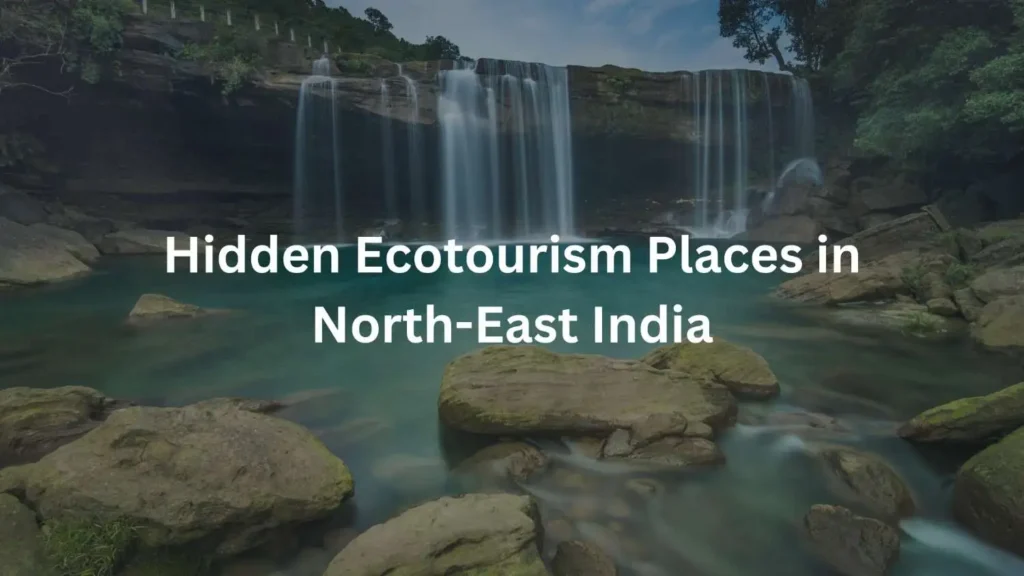
Introduction
Did you know that North-East India is one of the most biodiverse places on Earth, but less than 1% of tourists visiting India explore it? This shows a huge potential for ecotourism, offering not just beautiful scenery but also a way to support conservation and sustainable travel.
Let’s dive into some hidden ecotourism spots in Assam, Meghalaya, and Arunachal Pradesh. By visiting these places, you’ll experience stunning landscapes and unique cultures while helping to protect these fragile environments.
Hidden Ecotourism Gems in Assam
Majuli Island: The World’s Largest River Island
Discover Majuli Island’s Ecotourism
Majuli Island, situated in the Brahmaputra River, is a peaceful and culturally rich place. Known as the world’s largest river island, it’s home to the Mishing tribes and Vaishnavite monasteries.
Why It’s Important: Majuli is eroding, so sustainable tourism is crucial. Visiting helps support local communities and conservation efforts.
Things to Do on Majuli Island
- Bird Watching: See a variety of birds, both migratory and resident.
- Pottery Workshops: Learn traditional pottery from local artisans.
- Exploring Mishing Villages: Experience the rich culture of the Mishing tribes.
Manas National Park: A UNESCO World Heritage Site
Explore Ecotourism in Manas National Park
Manas National Park is a UNESCO World Heritage Site with incredible biodiversity. It’s a sanctuary for wildlife and a success story in conservation.
Why It’s Important: Manas is home to endangered species like the Bengal tiger and the Indian rhinoceros. Sustainable tourism helps fund conservation projects.
Things to Do in Manas National Park
- Jeep Safaris: Explore diverse landscapes and spot wildlife.
- River Rafting: Enjoy an exciting ride on the Manas River.
- Nature Walks: Learn about ecosystems and conservation from guides.
Hidden Ecotourism Gems in Meghalaya
Mawlynnong: Asia’s Cleanest Village
Experience Ecotourism in Mawlynnong
Mawlynnong, known as “God’s Own Garden,” is famous for being Asia’s cleanest village. The village is a model for cleanliness and sustainability.
Why It’s Important: Mawlynnong shows how sustainable practices can lead to successful ecotourism.
Things to Do in Mawlynnong
- Living Root Bridges: See the amazing natural bridges made from tree roots.
- Village Tours: Learn about the village’s sustainable practices.
- Waterfall Hikes: Discover hidden waterfalls and enjoy the peaceful surroundings.
Dawki: Crystal Clear Waters and Limestone Caves
Ecotourism Adventures in Dawki
Dawki, on the India-Bangladesh border, is known for its clear Umngot River and limestone caves. It’s perfect for nature lovers and adventure seekers.
Why It’s Important: Dawki’s pristine environment is ecologically important. Sustainable tourism helps keep it that way.
Things to Do in Dawki
- Boating on the Umngot River: Enjoy the clear river waters.
- Cave Exploration: Discover limestone caves.
- Camping by the River: Spend a night under the stars.
Hidden Ecotourism Gems in Arunachal Pradesh
Ziro Valley: The Land of Apatani Tribes
Discover Ecotourism in Ziro Valley
Ziro Valley, with its beautiful landscapes and rich culture, is home to the Apatani tribes. It offers a mix of natural beauty and cultural experiences.
Why It’s Important: Ziro Valley’s unique agricultural practices and culture make it an important site for sustainable tourism.
Things to Do in Ziro Valley
- Trekking: Explore scenic trails.
- Bird Watching: Spot rare and migratory birds.
- Experiencing Apatani Culture: Learn about Apatani traditions and festivals.
Namdapha National Park: Biodiversity Hotspot
Explore Ecotourism in Namdapha National Park
Namdapha National Park is one of India’s richest biodiversity hotspots, home to many rare and endangered species.
Why It’s Important: Namdapha’s diverse ecosystems are vital for conservation. Responsible tourism helps protect them.
Things to Do in Namdapha
- Wildlife Safaris: See a variety of wildlife.
- Birding Expeditions: Discover different bird species.
- Jungle Treks: Explore the dense forests.
Sustainable Travel Tips for North-East India
Ecotourism Best Practices in North-East India
- Travel Responsibly: Minimize your environmental impact and respect local cultures.
- Support Local Communities: Choose local guides, homestays, and businesses.
- Contribute to Conservation: Support ongoing conservation projects.
Conclusion
The Future of Ecotourism in North-East India
Encourage sustainable travel to preserve natural treasures. Explore and support North-East India’s ecotourism.
Historical and Cultural Context
Understanding the historical and cultural context of these ecotourism spots makes your travel experience richer. North-East India is a mosaic of indigenous cultures, traditions, and histories that shape its unique identity. From the ancient tribes of Arunachal Pradesh to the vibrant festivals of Assam, each destination offers a glimpse into a lifestyle closely tied to nature.
Why This Is Important for You:
- Cultural Sensitivity: Knowing the cultural context helps you be respectful and considerate of local customs.
- Environmental Awareness: Understanding the importance of conservation efforts highlights the need to preserve these treasures.
- Sustainable Impact: Realizing how ecotourism benefits local communities and environments encourages responsible travel.
- Enriched Experience: Historical and cultural knowledge deepens your travel experience, making it more meaningful.
By exploring these aspects, you’ll appreciate the importance of ecotourism in North-East India and be inspired to travel responsibly, helping to preserve these hidden gems.

